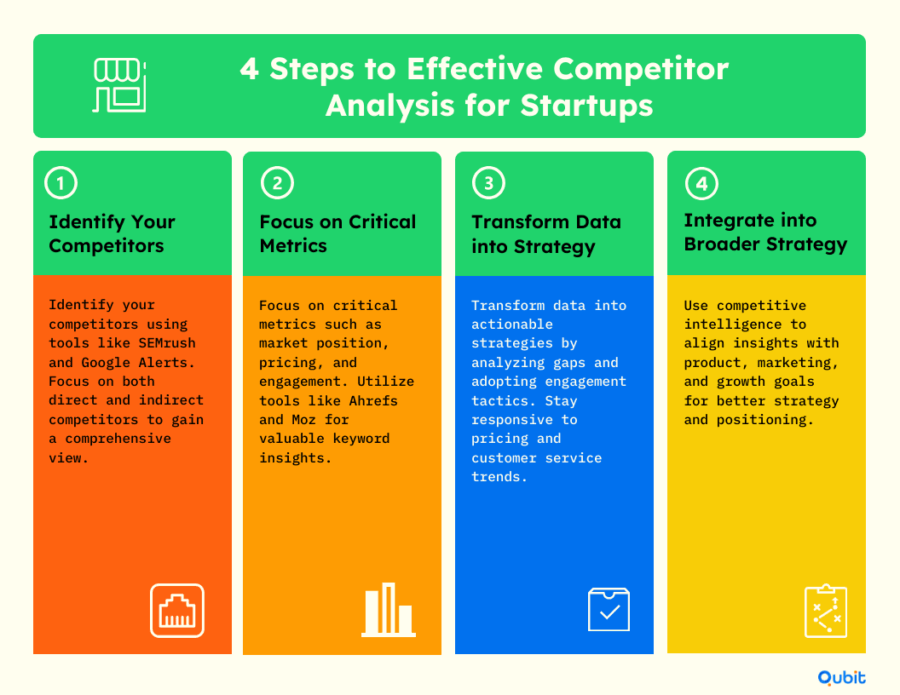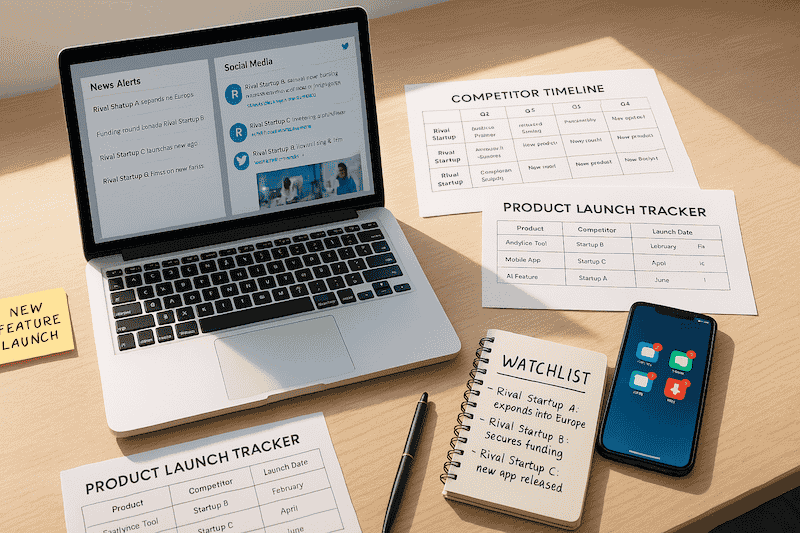Staying ahead in a competitive market requires more than just a great product or service—it demands a deep understanding of your rivals. Competitor analysis tools play a vital role in uncovering insights about market trends, pricing strategies, and customer preferences. These tools empower businesses to make informed decisions and adapt quickly to changing dynamics.
To build a robust competitive strategy, startups must first master how to identify competitors effectively, ensuring they focus on direct threats and market leaders. This foundational step sets the stage for tracking competitor activities with precision.
In this blog, we’ll explore the importance of staying informed about competitor strategies, highlight the best tools for competitor analysis, and provide actionable insights to help your business maintain a competitive edge.
Overview of Competitor Analysis Tools
Understanding competitor behavior is a cornerstone of strategic decision-making. Competitor analysis tools offer businesses the ability to uncover actionable insights across various domains, such as social media engagement, SEO performance, and multi-channel strategies. This section categorizes these tools based on their functionality, providing a clear understanding of how each type contributes to capturing competitor activities effectively.
Social Media Tracking Tools
Social media remains the top channel for customer engagement, making tracking tools indispensable for competitor analysis. These tools focus on monitoring engagement metrics like likes, comments, and shares, which are more critical than follower counts. For example, platforms like Hootsuite and Sprout Social allow businesses to analyze public social conversations, helping them understand competitor strategies and customer sentiment.
A case study involving Stoneacre Motor Group highlights the effectiveness of social media tracking. By analyzing public conversations, the company gained insights into competitor tactics and customer preferences, enabling them to refine their own strategies. Integration with social media tracking tools ensures businesses stay ahead in understanding market dynamics.
AI-Driven Insights
Artificial intelligence has revolutionized competitor analysis by automating data collection and providing predictive insights. Tools like Crayon and Klue use AI to track competitor activities, offering real-time updates on product launches, pricing changes, and marketing campaigns. These insights empower businesses to anticipate competitor moves and adjust their strategies accordingly.
AI-driven tools also excel at identifying patterns and trends that might go unnoticed with manual analysis. By leveraging machine learning algorithms, these platforms provide a deeper understanding of competitor behavior, helping businesses make data-driven decisions.
SEO Monitoring Tools
Search engine optimization (SEO) monitoring tools are essential for tracking competitor rankings and keyword strategies. Tools like SEMrush and Ahrefs allow businesses to analyze competitor backlinks, keywords, and overall SEO performance. This information can be used to identify gaps in their own strategy and optimize content for better visibility.
SEO monitoring tools also help businesses understand how competitors are driving organic traffic. By analyzing keyword trends and search engine rankings, companies can refine their own SEO strategies to stay competitive in search results.
Content Performance Analysis
Content performance tools focus on evaluating the effectiveness of competitor content across various platforms. Tools like BuzzSumo and Contently provide insights into which types of content resonate most with audiences, helping businesses tailor their own strategies.
Engagement trends show that high-performing content often correlates with strong engagement metrics. By analyzing competitor content, businesses can identify topics, formats, and channels that drive the most interaction, ensuring their own content strategies align with audience preferences.
Multi-Channel Analysis Tools
Multi-channel analysis tools offer a comprehensive view of competitor activities across various platforms, including social media, email marketing, and paid advertising. Tools like Adbeat and SimilarWeb provide insights into competitor ad spend, audience demographics, and campaign performance.
Choosing the best tools for competitor analysis depends on your specific needs. For startups, a competitor monitoring tool like Crayon can provide a holistic view of competitors’ activities, while Klue is ideal for sales-driven strategies.
Customer Sentiment Analysis Tools
Understanding customer sentiment is vital for shaping responsive marketing strategies. Customer sentiment analysis tools dive deeper into qualitative feedback from reviews, surveys, and social media interactions. For instance, Brandwatch enables businesses to capture nuanced customer opinions, tracking emerging trends and public perceptions over time. These tools filter through vast amounts of unstructured data to highlight both positive experiences and areas for improvement. They enable companies to benchmark against competitors and refine their communication strategies accordingly.
Market Trend Analysis Tools
Market trend analysis tools complement competitor insights by evaluating broader industry movements and consumer behavior patterns. Tools like Google Trends offer businesses the ability to compare search interest over time, identifying emerging topics and shifting preferences that might impact market dynamics.
These tools correlate competitor activities with overall market trends. They empower companies to adjust their strategies in real time. This approach ensures alignment with current consumer interests and forecasted market conditions.
Broader Benefits for Investment Readiness
Understanding the competitive landscape can directly influence how startups approach investor discovery, especially when identifying how to find investors for startups who align with their market and goals. Competitor insights provide a clear picture of market trends and opportunities, making businesses more attractive to potential investors.
Competitor analysis tools are not just about staying ahead in the market; they also play a crucial role in shaping long-term strategies and investment readiness. By integrating these tools into their operations, businesses can position themselves as informed and strategic players in their industry.
Strategies for Effective Competitor Analysis
Understanding your competitors is essential to staying ahead in any industry. Effective competitor analysis involves identifying key players, evaluating critical metrics, and turning insights into actionable strategies. This section outlines a step-by-step guide to mastering competitor analysis, highlights advanced tools like AlphaSense, Klue, and Crayon, and provides expert tips for integrating findings into a broader business strategy.

1. Identifying Your Competitors
The first step is to pinpoint who your competitors are. These can be categorized into:
- Direct Competitors: Businesses offering similar products or services to the same target audience.
- Indirect Competitors: Companies that fulfill the same customer needs but through different products or services.
Start by analyzing your industry and market trends. Tools like Google Alerts or SEMrush can help track mentions of competitors, while customer feedback can reveal which alternatives they’re considering.
2. Focusing on Critical Metrics
Competitor analysis is most effective when you focus on the right metrics. These include:
- Market Position: Assess their market share and growth trajectory.
- Pricing Strategies: Compare pricing models to identify gaps or opportunities.
- Customer Engagement: Analyze their social media presence, reviews, and customer loyalty initiatives.
- Content and SEO Performance: Use tools like Ahrefs or Moz to evaluate their keyword rankings and backlink profiles.
For startups aiming to stand out, crafting a compelling startup unique value proposition is a critical step in distinguishing your business from competitors and appealing to your target market.
3. Transforming Data into Strategic Actions
Raw data alone won’t drive results—it’s how you interpret and act on it that matters. For example:
- If a competitor excels in customer engagement, consider adopting similar tactics, such as personalized marketing campaigns.
- If their pricing strategy is undercutting yours, explore ways to add value to your offerings without compromising profitability.
For deeper strategic planning, conducting a SWOT analysis for startups provides a clear framework to evaluate internal strengths and external opportunities while staying vigilant about competitor threats.
4. Integrating Insights into Broader Strategies
The final step is to align competitor insights with your overall business goals. Use these insights to refine your product offerings, marketing campaigns, and customer engagement strategies. For example, analyzing competitors’ content strategies can inform your approach to using competitive intelligence for growth.
Additionally, real-time competitor data can be pivotal in strategy refinement. Effective competitive analysis for startups not only reveals industry trends but also helps in crafting strategies to outperform rivals.
Competitor analysis is not a one-time task but an ongoing process. By identifying key competitors, focusing on critical metrics, and utilizing advanced tools, you can transform raw data into actionable strategies that drive growth.
Conclusion
Staying ahead in a competitive market requires more than just intuition—it demands a structured approach to competitor analysis. By utilizing a combination of tools, from social media platforms to AI-driven insights, businesses can uncover opportunities and anticipate challenges effectively. These strategies not only provide a clearer view of market dynamics but also empower organizations to make informed, strategic decisions that drive growth and innovation.
Integrating systematic competitor monitoring into your business strategy ensures you're not just reacting to market trends but actively shaping them. This proactive approach is key to maintaining a leadership position in any industry.
We at Qubit Capital can assist you in transforming these insights into actionable strategies. Explore our Investor Discovery and Mapping service to connect with the right investors and position your business for success. Let’s work together to turn insights into impactful outcomes.
Key Takeaways
- A diverse array of competitor analysis tools exist to meet specific tracking needs.
- Social media analytics, especially engagement metrics, are crucial for industry insights.
- AI-driven platforms enhance competitive intelligence with automated alerts and predictive analytics.
- Structured competitor analysis involves identifying direct competitors, focusing on key metrics, and turning insights into actionable strategies.
- Real-world case studies and detailed tool comparisons provide the foundation for a successful competitive strategy.
Frequently asked Questions
Which tool is best for competitor analysis?
The ideal tool for competitor analysis depends on your specific business objectives. For instance, SEMRush and Ahrefs provide comprehensive SEO insights, while AI-driven platforms like Kompyte offer automated competitor tracking with real-time updates.


 Back
Back



